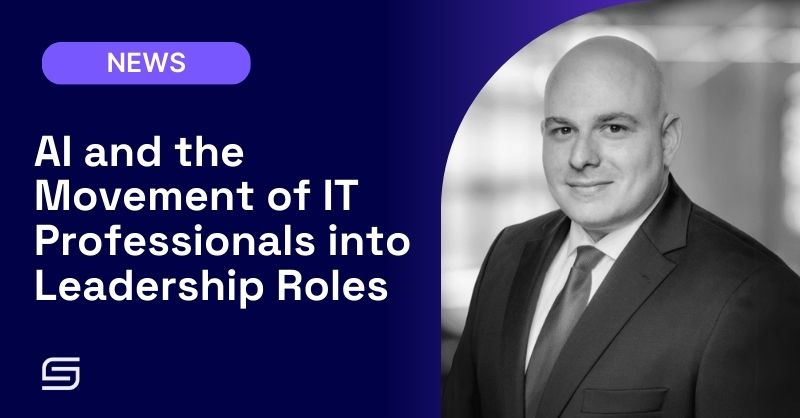AI and the movement of IT professionals into leadership roles

This interview originally appeared on Silicon Republic, by Laura Varley
Boris Kuiper discusses how IT experts are emerging as leading figures in the implementation of AI into the workplace.
According to Boris Kuiper, the COO and CFO of IT talent and training solutions platform Smoothstack, IT professionals are starting to take on leadership roles more frequently in areas such as AI strategy as they bridge the gap between technology and enterprise objectives.
“These folks are not only implementing AI solutions, but also helping to guide their organisations in ethical AI adoption. Thus, ensuring there is good alignment with strategic goals and fostering a culture of continuous learning. It is this shift that will position them as integral to driving AI initiatives that are both seen as innovative and responsible,” said Kuiper.
Furthermore, artificial intelligence is reshaping traditional IT responsibilities by automating and streamlining the tedious tasks that developers typically dread.
“It enables faster, more efficient workflows,” he said. “This shift allows companies to redirect budget into innovation instead of sinking in technical debt. Unfortunately, only about 4pc of large companies have effectively adopted AI in a significant way, highlighting the significant gap between potential and implementation.”
Addressing the challenges
Kuiper stated one major challenge that has arisen as a result of the AI alteration of the workforce is a growing skills gap. He explained that many IT teams are lacking the AI expertise required to implement and manage tools effectively. Additionally, there can be a resistance to change, as fears of automation threatening the availability of traditional jobs is hampering efforts.
“Integrating AI into legacy systems can be both complex and costly,” he said. “For example, retraining staff to use AI-powered monitoring tools or adapting outdated infrastructure to work with AI-driven analytics can be both a time-consuming undertaking and expensive to boot.”
He asserted that for organisations to truly get ahead and thrive in an AI-driven workplace, IT experts will have to expand upon their expertise in areas beyond traditional technical skills.
“This means strengthening data analysis capabilities, gaining proficiency in AI and machine learning and honing essential soft skills such as critical thinking and effective communication,” he explained. “Continuous learning is no longer optional, it’s a necessity. Just as crucial is adaptability, since the rapid evolution of AI requires professionals to stay on top of emerging methodologies and technologies.”
Human approach to AI
For Kuiper, the next big workforce transformation isn’t about replacing human workers, it is about retraining IT teams to think like AI managers.
“The upcoming transformation now centres on empowering IT teams to manage and collaborate with AI systems effectively,” said Kuiper. “Rather than putting the focus on automation replacing jobs, the emphasis is now turning to equipping IT professionals to be better at jobs.
“Gaining skills to oversee and run AI operations, ensure its being implemented ethically and integrating AI solutions that increase and enhance human capabilities. It’s this kind of approach that fosters a symbiotic relationship between human expertise and AI. Thus, leading to more innovative and efficient outcomes for the organisation.”
He explained that managing people and managing AI are fundamentally different experiences. When it comes to AI, you don’t have to consider personal issues such as illness or burnout, but you do have to be aware of accountability and the alignment of expectations.
“When a product fails, you cannot blame AI. The real question becomes, who was responsible for ensuring the AI was properly aligned with the project’s goals and requirements?”
He is of the opinion that capstone projects, interwoven into standard training programmes, can be an ideal way to specifically upskill early talent developers, as they work towards becoming AI native developers.
“When it comes to upskilling existing teams, the biggest hurdle is the change management component and aligning incentives,” said Kuiper. “It’s counter-intuitive, but a developer with more than 10 years of experience is not incentivised to adopt AI into their process.
“This is due to the learning curve, they actually become less productive while they learn how to use AI effectively. Long-term benefits align, but the short-term dip in performance is a large deterrent. This can be easily overcome with a good change management process which incentivises growth.”
Looking to the future Kuiper predicts that IT positions will shift significantly over the coming years, as more companies are able to adapt and adopt AI into their development processes.
“AI native developers are going to be the most sought-after and valuable developers in the market. Humans will still be the guardrails, the creatives, the ultimate decision-makers, the stakeholders and the accountable parties.”
Let’s Build Your Team
Connect with the Smoothstack team to learn how to close your digital skills gap with a custom-trained team.